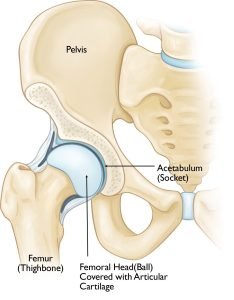Dr Amit Saoji | Orthopedic Surgeon In Nagpur | Orthopedic Doctor in Nagpur
Best Hip Replacement Surgeon In Nagpur
Home / Best Hip Replacement Surgeon In Nagpur

Best Hip Replacement Surgeon
The hip is one among the body’s largest joints. it’s a ball-and-socket joint. The socket is made by the socket, that is a component of the pelvis bone. The ball is that the leg bone head, that is that the higher finish of the femoris (thighbone). The bone surfaces of the ball and socket square measure lined with body part gristle, a swish tissue that cushions the ends of the bones and permits them to maneuver simply.
A Hip replacement surgeon is a doctor who focuses on evaluating and treating conditions that will need surgery, or physically dynamical the physical structure. Surgeries is done to diagnose or treat malady or injury. within the surgery, surgeons lead a team of different doctors and nurses to form positive that a procedure goes swimmingly.
Common Causes of Hip Pain
The most common reason behind chronic hip pain and incapacity is inflammatory disease. degenerative arthritis, autoimmune disorder, and traumatic inflammatory {disease} square measure the foremost common types of this disease.
Osteoarthritis. this can be age-related wear and tear style of inflammatory disease. it always happens in folks fifty years elderly and older and infrequently in people with a case history of inflammatory disease. The gristle padding the bones of the hip wears away. The bones then rub against one another, inflicting hip pain and stiffness. degenerative arthritis may additionally be caused or accelerated by delicate irregularities in however the hip developed in childhood.
Rheumatoid inflammatory disease. this can be Associate in Nursing disease during which the tissue layer becomes inflamed and thickened. This chronic inflammation will harm the gristle, resulting in pain and stiffness. {rheumatoid inflammatory disease|atrophic arthritis|rheumatism|arthritis|autoimmune disease|autoimmune disorder} is that the most typical style of a gaggle of disorders termed inflammatory arthritis.
Posttraumatic inflammatory disease. this may follow a significant hip injury or fracture. The gristle could become broken and result in hip pain and stiffness over time.
Osteonecrosis. Associate in Nursing injury to the hip, like a dislocation or fracture, could limit the blood offer to the leg bone head. this can be referred to as osteonecrosis (also generally remarked as avascular necrosis). the dearth of blood could cause the surface of the bone to collapse, and inflammatory disease can result. Some diseases may cause osteonecrosis.
Childhood hip illness. Some infants and kids have hip issues. although the issues square measure with success treated throughout childhood, they will still cause inflammatory disease later in life. This happens as a result of the hip might not grow ordinarily, and therefore the joint surfaces square measure affected.
Description
In a total hip replacement (also referred to as total hip arthroplasty), the broken bone and gristle is removed and replaced with prosthetic parts.
The broken leg bone head is removed and replaced with a metal stem that’s placed into the hollow center of the femoris. The leg bone stem is also either cemented or “press fit” into the bone.
A metal or ceramic ball is placed on the higher a part of the stem. This ball replaces the broken leg bone head that was removed.
The broken gristle surface of the socket (acetabulum) is removed and replaced with a metal socket. Screws or cement square measure generally wont to hold the socket in situ.
A plastic, ceramic, or metal spacer is inserted between the new ball and therefore the socket to permit for a swish flight surface.
When Surgery is usually recommended
There square measure many reasons why your doctor could advocate hip replacement surgery. people that have the benefit of hip replacement surgery typically have:
Hip pain that limits everyday activities, like walking or bending
Hip pain that continues whereas resting, either day or night
Stiffness in an exceedingly hip that limits the flexibility to maneuver or elevate the leg
Inadequate pain relief from anti-inflammatory drug medication, physiatrics, or walking support.
The orthopedical analysis
An analysis with Associate in Nursing orthopaedic medico consists of many components:
Medical history. Your orthopaedic medico can gather data concerning your general health and raise questions on the extent of your hip pain and the way it affects your ability to perform everyday activities.
Physical examination. this can assess hip quality, strength, and alignment.
X-rays. These pictures facilitate to see the extent of harm or deformity in your hip.
Other tests. sometimes alternative tests, like a resonance imaging (MRI) scan, is also required to see the condition of the bone and soft tissues of your hip.
